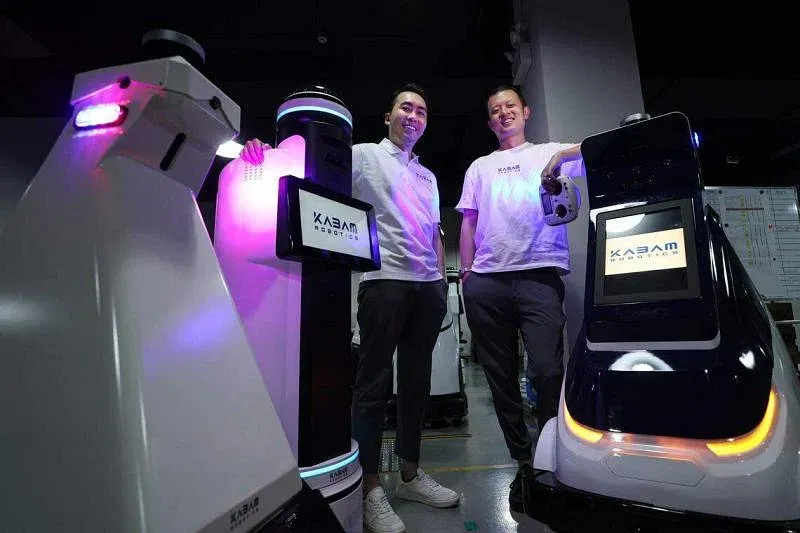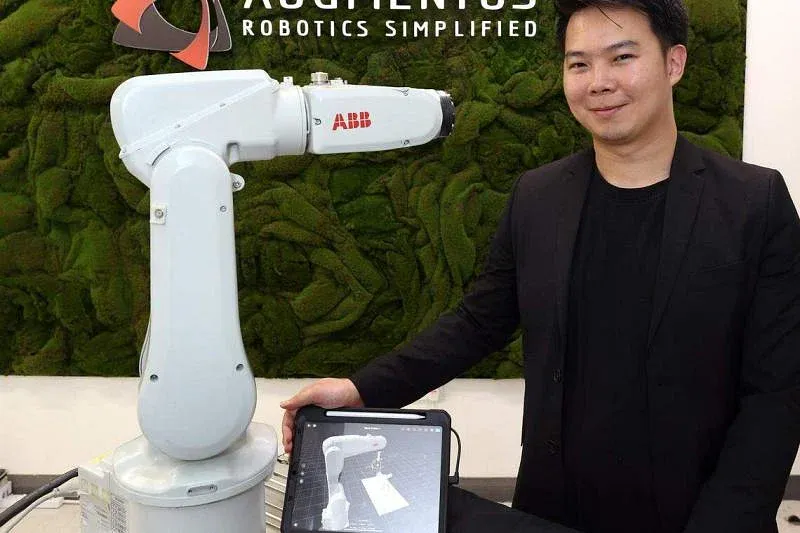ROBOTS have become a common sight, solving labour shortages everywhere from shopping malls to factory floors. According to a 2021 report by the International Federation of Robotics, Singapore has 605 robots installed per 10,000 employees in the manufacturing industry -- the second-highest figure globally, after South Korea's 932.
Just as human workers are encouraged to upskill and pivot, robotics firms are finding new uses for their creations, taking their technological offerings from one industry to another.
Transforma: From painting walls to coating oil tanks

From carrying out inspections and painting on construction sites, Transforma Robotics' creations will soon be rolling into the oil and gas industry too.
Spun off from Nanyang Technological University's School of Mechanical and Aerospace Engineering (MAE) in 2017, Transforma began by developing robots for the construction and infrastructure sector.
Its earlier models carried out quality inspections and assessments as well as painting large wall sections. Its robots will now be put to use in the maintenance and inspection of oil storage tanks.
Transforma started on this project after winning the Energy Open Innovation Challenge organised by Enterprise Singapore in 2020. The company intends to launch its newest robot in the market next year.
Chen I-Ming, chairman of Transforma and MAE professor, explained that due to the nature of the paint mixture used for oil storage tanks, workers must paint very quickly. "Hence, humans may sometimes not pay attention to the coat quality, such as ensuring the (uniform) thickness of the paint."
In contrast, Transforma's robot is capable of vision-based precision painting and coating. Its software module controls the robot's movement, paint pump parameters and distance to the surface, to ensure the paint coat has a consistent thickness.
Doing the tougher tasks
The new robot can help fill labour gaps in industries such as oil storage, particularly as educational levels rise and fewer Singaporeans are keen to take up laborious blue-collar jobs, said Prof Chen.
"The type of work done in those industries is still considered dangerous and dirty. These are the main considerations preventing people from working in the sector," he added.
Danger and dirt are no concern for a robot, which also ensures its human colleagues are not exposed to health risks from toxic paint fumes.
Prof Chen hopes that this foray into oil and gas will help Transforma become a major global robotic automation provider.
"Although Singapore has a good position in the oil and gas industry, the market is still quite small," he explained. "In order to scale up and unlock the industry's high value, we need to... move into regional markets, China and the Middle East."
Kabam Robotics: Patrol bots keep an eye on cleanliness

Typically, when a security guard in a shopping mall notices a puddle on the floor, he has to find a cleaner and ask them to help. But a robotic partner can save him the trouble.
Kabam Robotics' wheeled creations can detect issues such as liquid spillage and faulty lights, and alert mall operators -- easing the burden of human guards.
The company was formed in 2020, when demand for security robots was high due to Covid-era curbs on manpower. Its clients included security company Certis Cisco, which needed robots to carry out security checks, patrols and inspections.
Kabam's robots have since gained roles in facilities management too, aided by the company's merger with local software startup Cognicept Systems in 2022.
While Kabam's expertise is in machine design and manufacturing, Cognicept specialises in technology that lets customers track, guide and fix issues with their fleet of robots remotely.
Kabam's proprietary operating system, Smart+, was developed using the fundamentals of Cognicept's software.
Powered by Smart+, Kabam's indoor robot Co-Lab and its outdoor counterpart Halo can patrol and inspect facilities such as malls, and provide real-time system alerts to operators. The robots can take elevators on their own, and even provide concierge services by answering queries from shoppers.
The robots are modular and can be customised to meet individual customer's needs through an extensive options list, said Benjamin Chia, Kabam's commercial manager and co-founder.
Customers can buy or lease Kabam's robots together with the software, or buy Smart+ on its own. Co-Lab makes up 50 per cent of Kabam's revenue, while Halo accounts for 35 per cent and the software, 15 per cent.
More than 150 robots have been deployed in Singapore and overseas, including in Jewel, Paya Lebar Quarter Mall and Toa Payoh HDB Hub.
One challenge to adoption is a lack of awareness, said Kelvin Wee, director and co-founder of Kabam: "People are unsure about what this technology can do. They can't imagine what it can do and are uncertain about its returns on investment."
Kabam's answer -- robots can tackle the perennial manpower shortage. Wee noted that robots can "reduce headcount requirements per site".
Robots can also optimise the daily operations of human workers, said Chia. They can help with repetitive tasks such as patrolling, checking for defects and answering shoppers' questions, while their human counterparts tend to more urgent matters.
Said Wee: "We want to create a solution that empowers not just companies or employers but also users, to make their lives easier and the solution more reliable, consistent and efficient."
He added: "Interestingly, there aren't many global incumbent competitors in the security and facility management field. So we really believe that we have a chance to build a global brand out of Singapore."
Augmentus: Giving non-experts control

Tackling manpower shortages through automation can create a new issue: the need for skilled professionals to handle the automated system. Augmentus' software solves this problem by simplifying the process, such that even non-professionals can control robots.
Augmentus was founded in 2020 by a team of engineers at the Agency for Science, Technology and Research (A*Star) and entrepreneurs. They believed that existing automation processes required significant coding and programming skills, posing a challenge to companies and non-technical users.
Yet automation is crucial for small and medium-sized enterprises, said co-founder and chief executive Leong Yong Shin: "They can't compete with MNCs (multinational corporations) on salary, so they would need robots to help them solve their manpower crunch. But they also lack the required expertise to maintain the robots."
Leong was previously a technical lead at A*Star, where he founded a technology division and developed industrial solutions.
"I started to realise that robots are not very clever, and I had to teach the robot, step by step, how to perform a relatively simple task," he said. "There needs to be a simpler way to control the robots."
Leong was further inspired when he went on a business trip to Japan and saw how manufacturing workers there, in their 40s to 60s, were carrying out "manual, tedious and repetitive" tasks.
"This gave me the inspiration to double down on simplifying robotics control so that the supply chain and manufacturing sector can still be sustained, even though there is a dramatic shift in demographics worldwide," he said.
Augmentus is a no-code simulation platform that allows users to control robotic arms in a simplified manner.
Users can either import computer-aided design files or take a 3D scan of their workplace, then simply draw the path that the robot should follow. Through artificial intelligence, the software will generate the required motion for the robot.
The team focused on deep-tech development for two years. They launched the product in the second half of 2022 after Covid-19 restrictions were lifted, allowing Leong and his team to meet clients in person.
Augmentus began by providing solutions in metal processing -- for robotic arms that perform tasks such as sandblasting, sanding and polishing -- as these markets were relatively underserved.
In mid-2022, it expanded to offer welding and thermal spray applications. Late last year, as demand for robotics rose in the storage and logistics sector, Augmentus started providing "pick and place" solutions too.
The metal processing industry now makes up 70 per cent of Augmentus' revenue, while logistics makes up the remaining 30 per cent.
The software is integrated into the robotics systems of manufacturers, who pay an annual subscription. "Annual subscription lowers the upfront capital required for our end-customers," said Leong, who added that new productivity-boosting features are constantly rolled out on the platform.
Augmentus plans to set up its first subsidiary in the United States by year-end, and is in the middle of a fundraising round for this.
The US has a large manufacturing industry and is the second-largest user of robotic systems in the world, Leong noted. "For us to really scale rapidly, it would be much more effective if we have a local team there to secure partners in a much faster way."
The ultimate goal for Augmentus is to help firms streamline production, by enabling a single robotic system to handle multiple processes.
"Instead of having a very large factory with many production lines and robotic systems, the future of production will (have factories that are) much smaller (yet) can handle much more than what they can now," he said.
"We can free up humans to do much more meaningful work in the future."
Source: The Business Times © Singapore Press Holdings Limited. Reproduced with permission.

